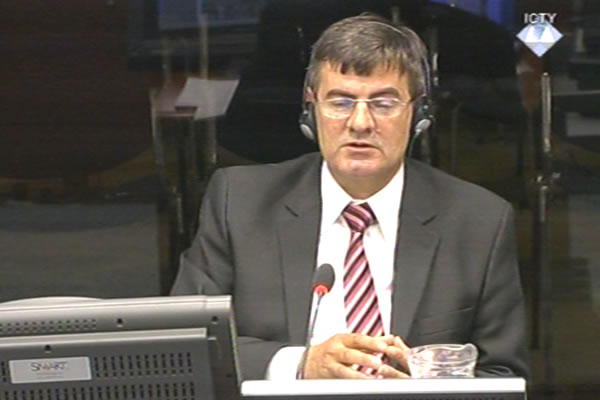Home
KARADZIC HIDES BEHIND BUILDINGS, SHRUBBERY AND FOG
Ballistic expert Mile Poparic contested the prosecution’s allegations that the Bosnian Serb army soldiers were responsible for sniper attacks on Sarajevo civilians. Poparic argued that in many cases the incident sites weren’t visible from the Serb positions as they were behind buildings, shrubbery, or hidden by fog. In some cases the BH Army could see the locations of attacks, Poparic argued
 Mile Poparic, defence witness of Radovan Karadzic
Mile Poparic, defence witness of Radovan Karadzic Ballistic expert Mile Poparic began his evidence yesterday in Radovan Karadzic’s defense. Poparic denied that the Bosnian Serb army soldiers were responsible for the sniper incidents listed in the indictment. Or, at least, they didn’t shoot civilians in Sarajevo during the siege deliberately, Poparic claimed. Poparic carefully examined the findings of the crime scene investigations conducted by the Sarajevo police during the war and the subsequent investigations conducted by the OTP. Also, Poparic visited the incidents scenes and the positions from which the shots were fired, according to the indictment. Poparic’s report and his findings were admitted into evidence.
For the most part, Poparic argued that there was no line of sight from the Bosnian Serb positions to the targets. The witness claimed that the sites of most of the 17 sniper incidents listed in the indictment against Karadzic weren’t visible from the Serb positions for a number of reasons. In some cases, buildings or shrubbery, absent now, blocked the view. As for the incident in which Munira Zametica was killed in July 1993, when she was drawing water from the river Dobrinja, the witness claimed that it couldn’t be established for sure if there was any ‘shrubbery including uncut grass’ by the riverbed. This could have blocked line of vision for the Serb snipers. The witness also recalled that the riverbed was paved and the victim may have been killed by a bullet that ricocheted during a gunfight between the two warring sides, the witness explained.
As for the incident in which a three-year old girl, Anisa Pita, was wounded on 13 December 1992, the witness noted that her father stated that there it was foggy that morning and that the fog lifted by the time Anisa was wounded. The question remains how high the fog layer was at the time of the incident: it may have been still enveloping the higher ground where the Serb positions were, the witness noted. In this and some other cases, Karadzic’s witness insisted that the wounded or killed civilians could be seen from the BH Army positions. This, according to the witness, meant that it was not sure who shot them.
The witness contested the allegation that a number of incidents involved sniper fire, stressing that in their statements, the victims said that they had heard bursts of gunfire before they were wounded. In one case the distance between the Bosnian Serb positions and the place where a civilian was shot was 1,245 meters. As the sniper range is 1,200 meters the witness concluded that fire was opened from a machine gun.
Although he is a ballistic expert, during his evidence Poparic dealt with legal issues, arguing that there were inconsistencies in the witnesses’ statements, and discrepancies between the findings of the Sarajevo police investigators and the OTP investigators. The witness also spoke about medical topics, explaining that some incidents couldn’t be properly analyzed without the missing forensic and medical documents, such as the findings on entry and exit wounds.
Prosecutor Edgerton reacted several times today, noting that ‘there is not a shred of a ballistic analysis’ in some parts of the evidence. Or, as presiding judge Kwon said, it could be said that the accused ‘is wasting time’ because he called a ballistic expert to present findings anybody else would be able to establish. Poparic continues his evidence tomorrow.
Linked Reports
- Case : Karadzic
- 2013-05-28 CREATING ‘NEW DEMOGRAPHIC PICTURE’ IN REPUBLIKA SRPSKA
- 2013-05-23 INTELLIGENCE OFFICER IN ‘SOAP BUBBLE’
- 2013-05-22 WITNESS KNEW NOTHING
- 2013-05-30 KARADZIC’S EXPERT: ENTIRE CITY OF SARAJEVO WAS NOT MILITARY TARGET
- 2013-05-31 NENAD KECMANOVIC – ‘PROPAGANDA VICTIM’
- 2013-06-05 KARADZIC’S BALLISTIC EXPERT COMPLETES EVIDENCE
